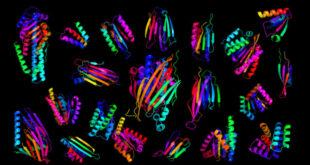
As we head into flu season, new batches of vaccines are being produced that will hopefully protect against this year’s most common strains of the virus. Even if you got vaccinated last year, influenza mutates so quickly you need this year’s vaccine to be well-protected. Researchers have long studied the properties of influenza that make it change rapidly, and a new study at MIT may offer a way to slow it down and make anti-viral drugs more effective by targeting your own cellular machinery.
Like all viruses, influenza replicates itself by invading cells and hijacking the components used by the cell to make new proteins. The flu virus carries eight strands of RNA coding all of its proteins, and more than one virus can infect a cell at a time. This provides an opportunity for different mutated strands to be packed up in new viral particles, creating new strains of the virus. This rapid evolution of influenza is why we have a new vaccine every year, but it also complicates the treatment of patients. A doctor might administer antiviral drugs only to have the infection mutate and escape.
The new MIT study investigated the effect certain specialized cellular proteins have on the mutation rate of influenza. These proteins, known as chaperones, are used in your cells to help proteins fold into their functional conformation. Proteins and enzymes have specific functionality because of their shape — patterns of positive and negative charges, hydrophilic and hydrophobic segments. Mutations change the structure of a protein, but chaperones can still nudge them into the right conformation. The team wondered what effect chaperones had on mutated influenza proteins, so they created a series of cell cultures with varying amounts of a chaperone protein called heat shock protein 90 (Hsp90).
The Hsp90 protein.
The cultures came in three flavors: restricted chaperones, extra chaperones, and normal chaperones. After infecting the cultures with influenza and sequencing the resulting viruses, the team found that Hsp90 did indeed help influenza mutate more quickly. Thus, the cell’s chaperones are helping mutated influenza proteins function, leading to viruses with more beneficial (for the virus) mutations.
Targeting this part of influenza’s reproduction could improve treatment. There are some drugs that inhibit chaperone activity, so administering those along with antivirals could slow viral mutation and make the antiviral more useful. The team is also investigating what effect chaperones have on other viruses like HIV, which also mutates rapidly.
Now read: What is the ‘antibiotic apocalypse,’ and can it be avoided?
 #Bizwhiznetwork.com Innovation ΛI |Technology News
#Bizwhiznetwork.com Innovation ΛI |Technology News




